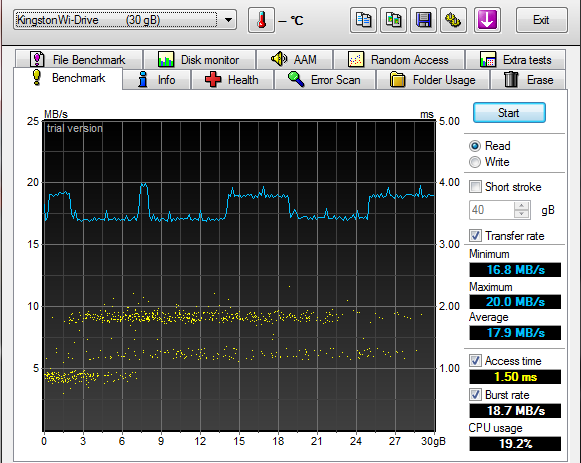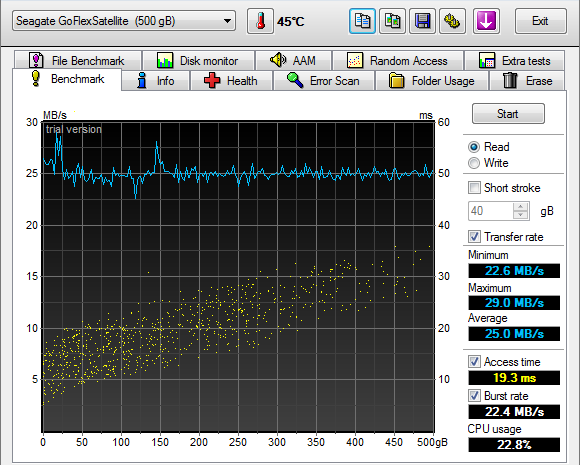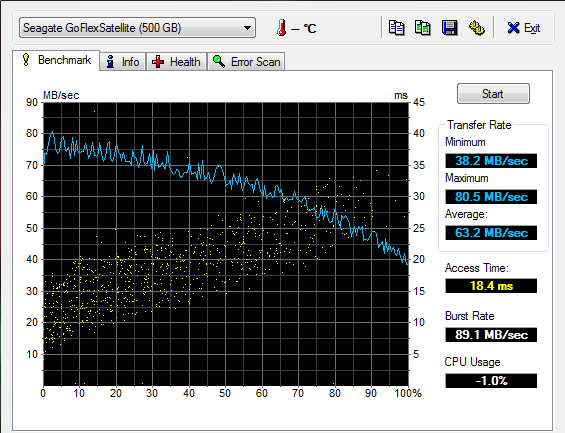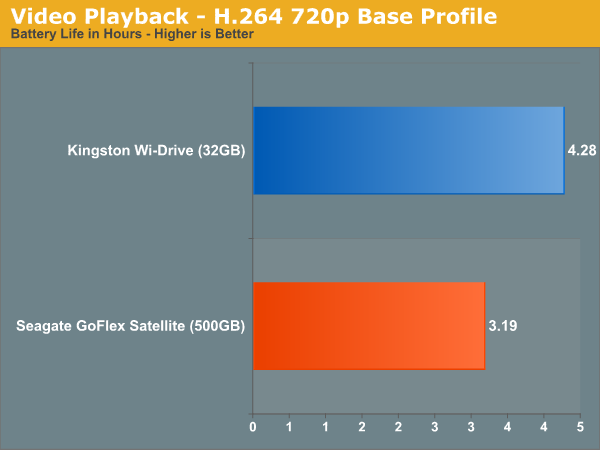Understanding Wireless Storage: Kingston Wi-Drive and Seagate GoFlex Satellite
by Vivek Gowri on November 21, 2011 2:30 PM ESTStorage and Wireless Performance
To test performance, I hooked both drives up to a PC and used HD Tune to get an idea of read performance and access time. The Kingston is USB 2.0 only and ends up performing roughly around the same level as the average USB flash drive. Access times are, as expected, significantly faster than the hard drive-based Seagate, but the NAND here is of the pretty low performance variety. Admittedly, this makes sense—cost and power consumption are far more important than outright speed in this type of application.

The Seagate has a SATA-to-USB 3.0 bridge, so it’s capable of significantly faster I/O speeds than the Wi-Drive. In the HD Tune graph over USB 2.0, we can see it’s basically pegged at the bandwidth limit of the interface (only around 25MB/s in this case, even though USB 2.0 can theoretically hit over 50MB/s). Switch to USB 3.0 and we get transfer rates typical of 5400RPM laptop drives.

GoFlex Satellite, USB 2.0

GoFlex Satellite, USB 3.0
Both drives are more than fast enough to stream high bitrate 720p video over 2.4GHz 802.11g/n, so long as you maintain a decent signal. I found that anything within 10 feet was good enough—I left both in a bag in the overhead bin on a 737 and connected just fine from my iPad at my seat. However, once you lose line of sight and start moving to distances of over 30 feet away from the streamer with a few walls and assorted furniture in between, you'll typically start to see some stuttering in the videos. That’s to be expected though, as it’s an extreme case for wireless range.
Battery Life
Battery life is an interesting topic. Kingston quotes a four hour battery runtime for the Wi-Drive while Seagate claims up to five hours on the Satellite's 10.36Wh battery, but it's not clear what kind of usage those figures represent. I fired up a trusty old loop of The Bourne Identity on each of the streamers playing through my iPad, placed the device two feet in front of the iPad, and unplugged it. I then time how long it is before the video dies, and that’s our winner.

Interestingly, the Kingston actually beat the claimed battery life spec, clocking in at 4:17, while the Seagate gave us pretty disappointing runtime at just under three and a quarter hours. It makes sense that the mechanical hard drive consumes more power, but it’s disappointing that our streaming HD video test undercut the claimed battery figures by that much.










32 Comments
View All Comments
hmurchison - Tuesday, November 22, 2011 - link
Some airlines are now offering in flight Wifi for a fee (usually $6)Kuhnian - Tuesday, November 22, 2011 - link
Can we write data to these devices ? Especially to the bigger one, the GoFlex Satellite.I'm an amateur ohotographer and the first time I heard of Satellite I thought that it could be the final mobile storage solution for photo safaris (100's to 1000's of raw photos in just one session at max resolution needs more than one sd card). I was thinking of connecting my Canon 60D with Satellite through an Eye-Fi card. But at first there wasn't enough info on the net and now after this review I'm beginning to suspect that it can do what I'm dreaming of.
inplainview - Tuesday, November 22, 2011 - link
Yes you can write to it, but if you are on a Mac, there are issues. Apparently there is a problem in Mac OS X 17.x that is causing the Sat not to show up in Finder. When you buy it they give you Paragon's NTFS software that is supposed to let you mount NTFS volumes under Mac OS, but it does not work. If you were to format the drive to read HFS+, you will lose the wifi capabilities, so in effect you can: a) Format the drive HFS+ and lose wifi, b) take your chances with the Paragon software and hope it does not hose your system, c) skip this thing all together and just use a regular external drive. While I like the idea from Seagate, it is not very reliable.Kuhnian - Tuesday, November 22, 2011 - link
I think you missed the point. I mean, can my Eye-Fi adapter send photo data to this disk wirelessly not over the usb (or other ports) cable.name99 - Wednesday, November 23, 2011 - link
The real answer, surely, is that these drives should support WebDAV.I'm kinda amazed that neither of them do --- this seems to indicate extraordinary incompetence on the part of both companies (backed up by this NTFS/reformatting the drive loses wifi nonsense --- WTF --- I perform what is essentially a SW operation and I lose HW functionality???)
IF such a drive supported WebDAV it could then be used by a variety of iOS and Android apps, which support WebDAV, and could (simultaneously, if that is useful) be attached to Finder or Windows Explorer, to allow a PC to easily add and modify files.
marvdmartian - Tuesday, November 22, 2011 - link
Is how easily/possible it would be to take the Seagate drive, and swap out the 2.5" hdd for a decent sized SDD?If it's do-able, that could easily give you the best of both worlds......the speed of the SSD, as well as the lower power consumption. You might not want to go whole hog with a 512GB SSD (as that would probably be prohibitively expensive), but even a 100 to 200GB capacity would still give you plenty of storage, and not break the bank.
name99 - Wednesday, November 23, 2011 - link
Given that we've already been told reformatting the drive LOSES the WiFi functionality --- apparently the genius designers neither included that functionality on separate ROM, nor used firmware tricks to prevent that section of the disk from being touched by a reformat --- swapping drives seems highly unlikely to generate any useful result. You will now have a larger than usual 2.5" drive, with NO WiFi capability, and which cost you a lot more than a standard 2.5" drive.tigertony9 - Tuesday, November 22, 2011 - link
One drive that was missing was the G-Technoogy G-Connect. http://www.g-technology.com/products/g-connect.cfmhmurchison - Tuesday, November 22, 2011 - link
I'm surprised the G-Technology drive is missing from this article. It's different from the GoFlex in that it doesn't offer a battery but it does have Gig-E ethernet so you can put it on a physical network when you need it.addendum:
I don't know why people keep ranting about MicroSD card slots. They're fine for augmenting storage but the ideal behind these products is sharing to multiple users. So if I'm traveling with my kids I can take a loaded drive and they can choose which content they want to watch or listen to. You can do that by simply shoving in SD card.
myapp11 - Tuesday, November 29, 2011 - link
How easy is it to remove the hard drives in the seagate wifi mobile device and the wi-drive device?I want to upgrade the hard drives?
Thanks